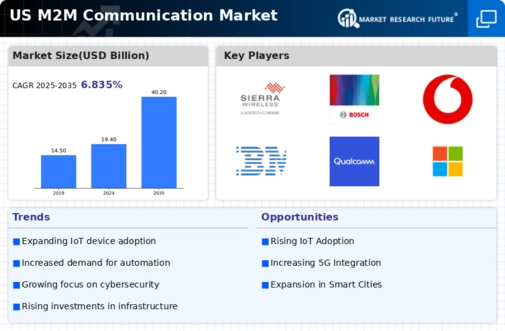The US M2M Communication Market has grown significantly, driven by advancements in technology and an increasing demand for connected devices across various industries. As businesses seek to enhance their operational efficiency, the market is characterized by intense competition among several key players striving to offer innovative solutions tailored to the diverse needs of their clients. This competitive landscape showcases a mix of established industry leaders and emerging companies, each vying for market share by focusing on improving connectivity, reliability, and value-added services.
The proliferation of IoT applications has further intensified this competition, as companies push to provide solutions that support real-time data transfer and analytics, creating opportunities for differentiation and customer engagement.
Sierra Wireless stands out in the US M2M Communication Market due to its extensive expertise in providing robust connectivity solutions that include both hardware and software components. The company has established a strong market presence through its innovative cellular modules and gateways that enable a wide variety of M2M applications across different sectors such as transportation, industrial automation, and smart cities. Sierra Wireless's strength lies in its commitment to research and development, allowing them to continually introduce cutting-edge products designed to enhance performance and security.
Furthermore, their strategic partnerships with network operators enable them to deliver seamless connectivity solutions, which are essential for businesses relying on real-time data communication and analytics.
Bosch also holds a significant position in the US M2M Communication Market, focusing on delivering comprehensive IoT solutions that combine advanced sensor technology, software, and connectivity services. The company's strengths stem from its diverse portfolio of key products and services, including automotive components, industrial automation systems, and smart home solutions. Bosch's commitment to innovation has propelled its market presence, allowing it to leverage breakthroughs in artificial intelligence and machine learning for enhanced data processing and decision-making.
Additionally, the company's proactive approach to mergers and acquisitions has enabled it to expand its capabilities and enhance its product offerings, making it a formidable competitor in the M2M arena. The integration of these advanced technologies within their extensive ecosystem allows Bosch to cater effectively to various industries, reinforcing their position as a leader within the US market.




















